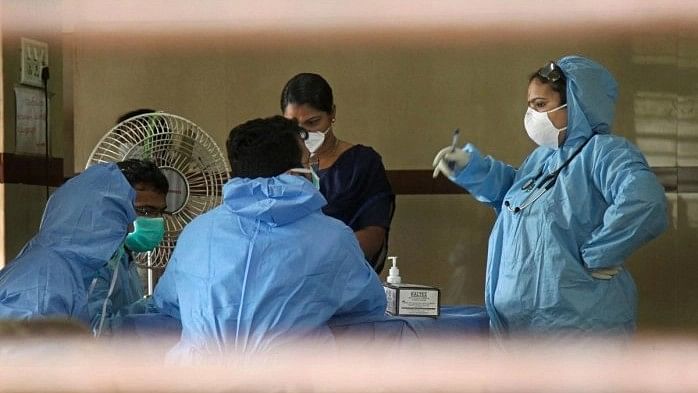
Fever surveillance would be intensified in the four border districts of Mysuru, Chamarajanagar, Dakshina Kannada and Kodagu.
Credit: PTI Photo
Check posts will be set up for fever surveillance at the entry points from Kerala to Karnataka, as per guidelines for Nipah prevention issued by the Health Department on Thursday.
Fever surveillance would be intensified in the four border districts of Mysuru, Chamarajanagar, Dakshina Kannada and Kodagu. Though there will be no travel restrictions, the public will be advised not to go to Kozhikode district where Nipah cases were reported.
At least two beds should be reserved for patients in all district hospitals to quarantine any suspected case, and negative pressure ICUs (that prevent spread outside the ICU) should be identified, the guidelines say. "The number of beds can be scaled up gradually. The idea is that, at any point, a government hospital should be able to free up 10 beds if needed," health commissioner D Randeep said.
Along with essential drugs and oxygen, hospitals should have sufficient stock of PPEs and the materials needed for sample collection and transport.
In a virtual consultation with district health officers (DHOs) on Thursday, the department asked to train health staff down to the primary health centre level for identifying and handling any suspected case. District Rapid Response Teams have to be on alert. All private health establishments should report any suspected Nipah case to the DHO concerned.
Guidelines issued by the National Centre for Disease Control (NCDC) for detecting cases should be strictly followed, and any suspected Nipah patients and their contacts should be monitored till the end of incubation period.
The four border districts have been asked to submit a compliance report on these preventive measures on Friday itself.
NCDC guidelines
"Currently NCDC's definition of suspected Nipah cases is very narrow," says Randeep. As per NCDC's guidelines, as of now, a suspected Nipah case is only a person from the affected community in Kozhikode who develops symptoms such as fever with headache, cough or shortness of breath, altered mental status or seizure. Nipah cases tend to occur in a cluster or as an outbreak, says the NCDC document.
Case fatality rate is estimated to be 40-75 per cent, but can go even up to 100 per cent. Drinking contaminated raw date palm sap and close physical contact with an infected person or animal are the two routes of transmission identified.
"The transmission rate is high in the primary spread from bats to humans. But it's low in the secondary transmission from humans to humans," Randeep said.
Since Nipah virus is classified as a biosecurity level-4 (BSL-4) agent, all samples should be sent to the National Institute of Virology, Pune, which is the designated testing lab, the guidelines say.
The guidelines specify how health staff should collect samples, take the person's medical history, etc.